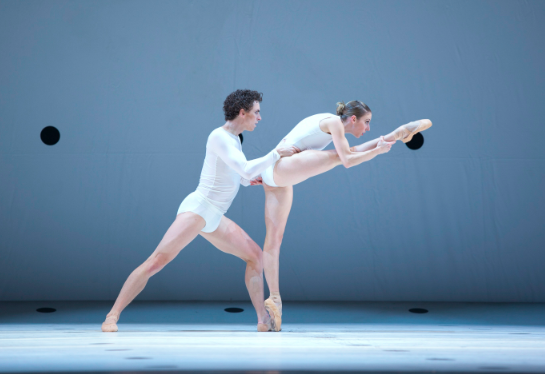It's been 13 years since The Australian Ballet was last in New York City. That's enough time, in dance years, for a generation of company dancers to have come and gone.
But they're very polite about re-introducing themselves. Luminous, the collection of pas de deux that opened the repertory program (Infinity) the company presented at the David H. Koch Theater last week, gave us a chance to get acquainted with the unfamiliar faces. Meant to add up to a historical tour of the company -- which is celebrating its 50th birthday this year -- the string of duets instead felt like a debutante ball. TAB's brightest dancers paraded out two by two, excited, it seemed, to meet us.
Luminous is so friendly, so well-meaning in its effort to orient the audience, and yet so misguided. Clunky video montages bracket each dance; though they're full of interesting old footage and some striking slow-motion shots of the company's current members, they can't make the mishmash of pas de deux feel cohesive, and their leaden dialogue ("This is a story of guts and determination") is often inaudible over the orchestral accompaniment.
The dances themselves reveal little about the personality of a company that's been struggling to define its personality for most of its short history. The pas de deux from Don Quixote and Act II of Giselle are ballet standards; Petal Miller-Ashmole's La Favorita pas de deux, set to Donizetti, is a trite imitation of Don Q. Molto Vivace's pas, by resident choreographer Stephen Baynes, is a moony, swoony treatment of an excerpt from Handel's opera Xerxes; the pas de deux and ninth movement of second resident choreographer Stanton Welch's Divergence are painfully tacky treatments of bits of Bizet's L'Arlésienne.
I wanted to like the dancers who bravely navigated these rough seas. And I did like many of them. TAB's dancers are on the whole clean and polished, free of fussy mannerisms. They present themselves in an appealingly unshowy way. Most of the cast of Luminous looked nervous, a little wooden, as if performing in a competition. I'm sure there were real nerves involved -- it's not just American audiences who've been eagerly anticipating this tour. But Daniel Gaudiello, in Favorita, impressed with his spring-loaded jump and natural command of the stage, and delicate, elegant Amber Scott, the company's reigning ballerina, enchanted in Molto Vivace.

The Australian Ballet's Kevin Jackson and Lana Jones in Dyad 1929. Photo by Lisa Tomasetti.
Sometimes contemporary ballets, since they're less exacting than big classical works, let companies have a little more fun onstage. Wayne McGregor's snaky choreography often pulls entirely different personae out of classical dancers, so I hoped, coming back from intermission, that his Dyad 1929 might help TAB's artists relax. Vaguely inspired by Ernest Shackleton's visit to the South Pole, and by the experimental spirit of the Ballets Russes, Dyad is as chic as we've come to expect McGregor works to be: There's a graphic black-and-white set complemented by a string of yellow fluorescent lights, a moody, propulsive score by Steve Reich (Double Sextet), and striking lighting design by Lucy Carter. But McGregor's choreography, with its signature eye-popping extensions and sinuous partnering, is also full of difficult transitions whose seams aren't supposed to show. It's deceptively hard to dance, and the 12 TAB members who performed Dyad looked tentative, even scared. You could see them hesitating for that extra millisecond during in-between moments, chopping phrases that should have flown together into disconnected bits. It wasn't as fun as it should have been.
TAB's dancers actually looked most comfortable in the work whose style was, in theory, most foreign to them. Warumuk - in the dark night is the third collaboration between TAB and Bangarra Dance Theatre, Australia's Indigenous dance troupe. Choreographed by Bangarra director Stephen Page (and set to a score by his brother David), Warumuk features dancers from both companies, and is inspired by aboriginal astronomy myths.
After watching it, do I have any idea what those myths might be? Not really. Australian audiences might already know them. Jacob Nash's beautiful sets -- gold constellations of stars, a giant hammered-metal full moon -- and Jennifer Erwin's elaborate costumes create a mystical, magical environment that's easy to lose yourself in. I don't know how true to indigenous tradition Page's choreography is. It's certainly alloyed with contemporary movement, but the proportions are unclear, at least to my untrained eye. I do know that the Australian Ballet dancers in Warumuk's cast seemed to relish its style: deep, rooted pliés, movements initiating from the gut, overt, unabashed theatricality. (The wonderful Bangarra artists aren't technical slouches, either. Even during more balletic phrases, it was often hard to tell which performers were from which company.)
Maybe TAB's dancers just needed to forget for a moment that they were ballet dancers, subject to ballet's oppressive standards -- because it was when they put on face paint and body paint, loincloths and headdresses, that they looked most like a world-class ballet company.

Artists of The Australian Ballet and Bangarra Dance Theatre in Warumuk - in the dark night. Photo by Jeff Busby.
--------
A former dancer and choreographer, Margaret Fuhrer is an associate editor at "Dance Spirit" and "Pointe" magazines.